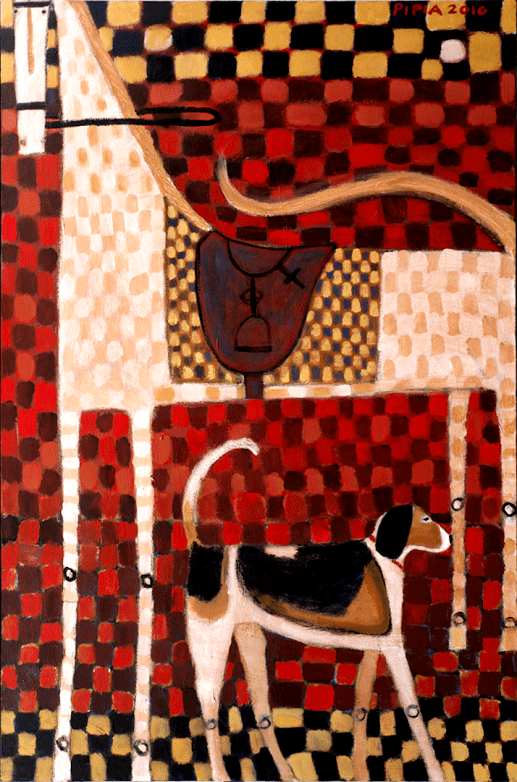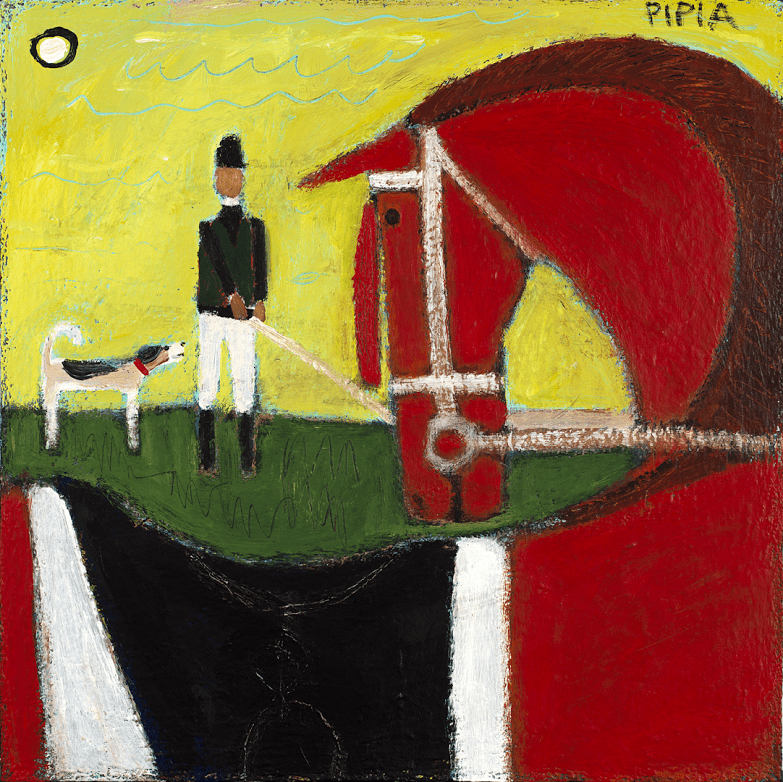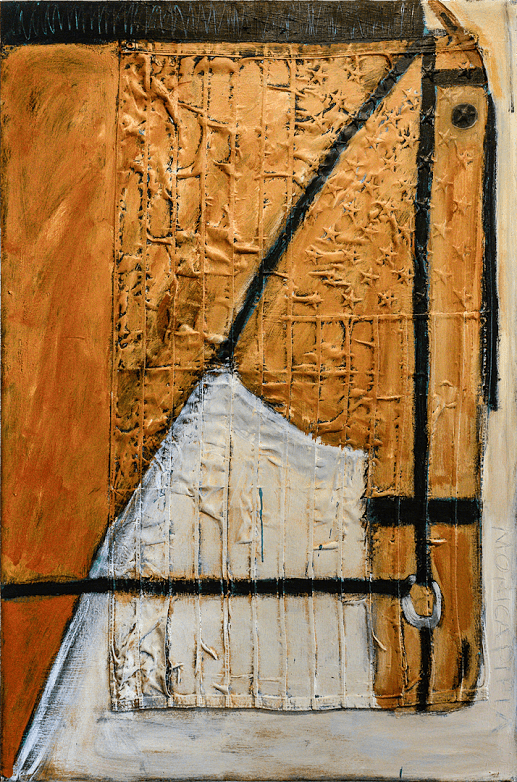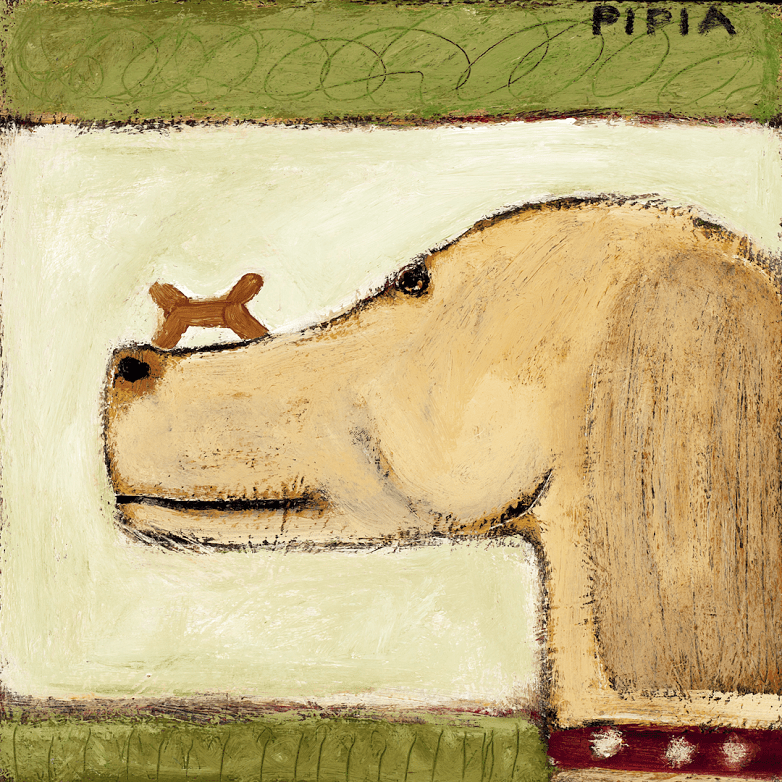In William Shakespeare’s play, King Richard III cries out, “A horse, a horse! My kingdom for a horse!â€Â His horse has been killed in battle and without it, he faces utter defeat and the loss of his throne.  Demonstrating the human race’s essential dependence on another quadruped, Emily Dickinson declares that “Dogs are better than human beings because they know and do not tell.â€Â
Pair the two, and what do you get? A brilliant and intelligent solo exhibit, American Horse and Hound, currently on display at John Hockensmith’s Fine Art Edition’s Gallery at 146 East Main Street in Georgetown, Kentucky. Although Monica Pipia, the artist, is considered a contemporary primitive painter, her work defies a singular classification because she has so fervently internalized and extemporized the two loves of her life, dogs and horses.
It is clear that her subject matter and her medium, acrylic on canvas (with some mixed media), determine how each piece evolves into a final work of art. Pipia says that “If I try to manipulate the brush, it’s always disastrous. I have to listen to my inner voice. Yes, as with most artists, I cogitate and calculate but I can’t make a painting be what it doesn’t want to be.â€Â This may sound trite, but what results is a technique and style uniquely and unmistakably Pipia.
The anchor piece of the exhibit, by the same title, depicts a static, statuesque checkerboard horse wearing a checkerboard blanket against a checkerboard background. Despite the stasis of the scene, this quilting technique makes the piece pulsate with color. Small, black irregular squares dominate the canvas contrasted with interwoven hues and values of red, brown, and gold. From all of this emerges a horse of a different color, suggesting overtones typical of American folk art.

Courtesy of Hockensmith’s Fine Art Editions
Pipia demonstrates in this work her ability to subtly infuse a strong sense of perspective and movement with the curved lines of the spotted yet motionless hound that dominates the foreground beneath the horse. But the real energy comes from what is actually not on the canvas: the rider. It is easy to become so entangled in the horse and hound’s mutually intense anticipation that our mind’s eye can’t help but see the person these animals see in the distance, headed toward them.
But never fear. Out of the 23 works in this exhibit, there are horses with riders present as in “The Turn-around.â€Â Here, the artist broadens the space and creates a wave-like movement from left to right, curling back again and cresting with the horse’s head. Through this imposed motion and fluidity, the focus then becomes the hound and the rider in the background.Â

Courtesy of Hockensmith’s Fine Art Editions
And in a more contemporary vein, Pipia employs a type of painterly synecdoche, where a part represents the whole. We do not see all of the horse nor do we need to. This, in turn, allows us to not only focus on the curvature of the animal itself, but to also enjoy the splashes of color and contemplate the positive and negative spaces created by the overall composition. It exudes a warm and exquisite beauty and the use of white in the saddle blanket, the rider’s pants and collar, the hound, and the sun lends a solid unifying element.
The real American spirit in this exhibit is at its best with some of the mixed media pieces where the artist has cleverly incorporated the American flag either literally or figuratively into work itself. For instance, in “American Horse Portrait” and “Pony Express†the flag symbolizes American progress that has been achieved through the power and strength of the horse. However, this utilitarian representation does not diminish Pipia’s presentation of the beauty, grace, and necessity of an animal that we still romanticize through our sports, leisure, and entertainment activities.

Courtesy of Hockensmith’s Fine Art Editions
“American Horse Portrait” serves as an excellent example of the artist’s contemporary primitive inclinations. One unique thread that runs throughout her work is in the way she places the bridle and reins on the horse. They are always angular and geometric and presented as an integral part of the horse without restraint. Another consistency is how she builds texture and layers the paint, using more colors than appear obvious at a glance, such as the brown, white and black seen here. This portrait, painted over a flag that has been attached to the canvas, is both beautiful and moving in its seeming simplicity. Yet the connotations of its conceptual complexity are vast, depending on what we, as viewers, bring to it based on our own knowledge and experience.
Pipia’s paintings also display a lot of joy and playfulness as “Balancing Act†confirms, where a canine is balancing a doggie treat on its nose. Hunter, companion, friend, and confidant. The message is clear in this profile that the slightest movement may result in the subject’s disappointment and displeasure with its failure to sit and stay still as it performs this feat. All the while we, too, are waiting for the command for it to toss its head in the air and make the bone disappear down the hatch. Such is the power of Pipa’s art to stimulate the imagination. Note the dog’s collar simulating a red stripe of the American flag with stars.

Courtesy of Hockensmith’s Fine Art Editions
The American Horse and Hound exhibit is joyfully positive and thought-provoking. Pipia’s work could easily fit into a number of categories but it is, first and foremost, original and representational as it strives to convey the essence of what it portrays. And it will allow you to easily tap into your own inner Shakespeare or Dickinson. After all, where would we be without horses and dogs, and who would want to live in a world without them?Â
The artist’s reception is on Thursday, June 30th, 6-8 pm. The exhibit runs through Saturday, July 30th.




